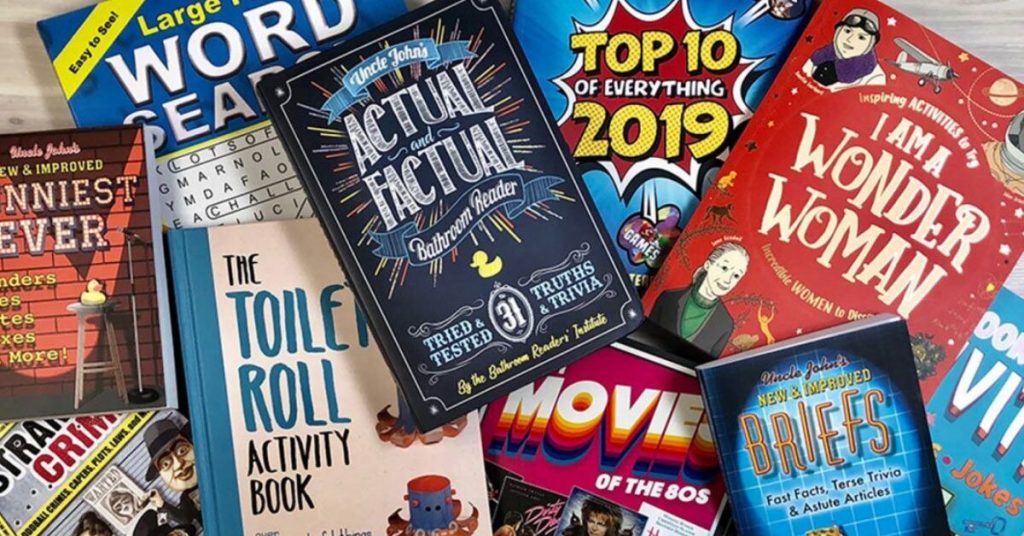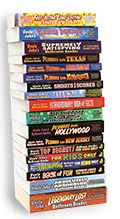Every week during Bathroom Reading Month, we will host a giveaway for a book of your choice from the Uncle John’s Bathroom Reader collection. Just to spice it up, we will ask you to answer a question on the blog. At the end of the week, we will pick a random winner from the answers and post it on the blog along with our favorite answers. Remember that this is in addition to our “mother-of-all” contest: enter to win the entire in-print library of Uncle John’s Bathroom Readers.
Week #2: In a Kids Book
QUESTION: If you could trade places with any character from a children’s story,
whom would you pick and why?
Answer the question in the comments section of this post to be entered to win a book of your choice from the Uncle John’s Bathroom Reader library. Answers must be posted by June 12, 2013, midnight PST to be eligible to win. A winner will be announced on Friday, June 14, 2013. Open to US residents only.
To inspire you, here is an article from Uncle John’s Endlessly Engrossing Bathroom Reader about some of the very first children’s books ever written.
____________________________________________________
CHILDREN’S BOOKS
Walk into any bookstore today and you’ll find walls full of books written specifically for kids. But a few hundred years ago it wasn’t like that—there were actually very few. Here are the first children’s books ever written.
THE COLLOQUY
Possibly the earliest example of literature made specifically for children, The Colloquy was written and distributed in England around A.D. 1005 by a Benedictine monk named Aelfric. At the time, the Benedictines were trying to use education to help Europe emerge from centuries of social decline, and this playful textbook was meant to teach kids about both careers and Latin grammar. The book is written in the form of dialogue between a teacher and several pupils (colloquy means “dialogue” in Latin), the pupils taking on the roles of several professions. An example:
Teacher: How did you dare to cut the boar’s throat?
Hunter: My dogs drove him towards me, and I stood against him and suddenly slew him.
Teacher: You must have been very brave indeed.
Hunter: A hunter must be very brave, since all kinds of beasts lurk in the woods.
THE DISTICHS OF CATO
This collection of witty proverbs for adults was written in Rome by Dionysius Cato around A.D. 300. Rediscovered in Europe in the 1200s, it was translated into many languages and used to teach children grammar and morals. Distich means “couplet,” which was the form of the writing. Example: “Be stupid when the time or situation demands / To fake stupidity is at times the highest prudence.” The Distichs of Cato remained one of the most popular Latin textbooks for several centuries—and even made its way to the American colonies, where it was published by Benjamin Franklin in 1735.
THE BOOK OF THE KNIGHT OF THE TOWER
In 1371 French aristocrat Geoffroy IV de la Tour Landry wrote this collection of fables to teach his two daughters proper behavior in royal society. The moral of one story: Do not have sex with a knight, because you might get pregnant, and then your father would have to drown you in a well in the dark and the knight would be “flayed alive.” The Book of the Knight of the Tower was translated into German and English and was very popular for two decades.
A TOKEN FOR CHILDREN
The 1600s were the height of the extremely conservative and religious Puritan movement in England. How did adults teach kids to fear hell? Pastor James Janeway’s A Token for Children: An Exact Account of the Conversion, Holy and Exemplary Lives and Joyful Deaths of Several Young Children, published in 1671. It’s a collection of stories about kids (some as young as two) who commit sins, see the error of their ways, become pious, and then die. But because they repented, their deaths are accompanied by beautiful lights and the singing of angels. For the next two centuries, A Token for Children was one of the most popular children’s books in England and the American colonies.
TOMMY THUMB’S PRETTY SONG BOOK
By the mid-1700s, attitudes toward children were changing—they were allowed to be what we think of as kids for the first time. Tommy Thumb’s Pretty Song Book, written by “M. Cooper” in 1744, was an early fun book, and is said to be the first published collection of nursery rhymes, many of them still familiar, including “Sing a Song of Sixpence,” “Baa Baa Black Sheep,” and “Hickory Dickory Dock.” Only one copy of Tommy Thumb’s Pretty Song Book exists today—in the British Museum in London.
A LITTLE PRETTY POCKET BOOK
First released in 1744, English author and publisher John Newbery’s A Pretty Little Pocket Book: Intended for the Instruction and Amusement of Little Master Tommy and Pretty Miss Polly consisted of illustrations, rhymes, and instructions for various games. An example, titled “Base-Ball”: “The Ball once struck off / Away flies the Boy / To the next destin’d Post / And then Home with Joy.” Newberry was the first publisher to market literature just for kids, emphasizing education through entertainment. To honor Newbery for essentially creating modern children’s literature, the American Library Association’s award for the best children’s book of the year is named the Newbery Medal.
**********************************
Our Father’s Day Sale is in full swing. 30% off the entire store and FREE shipping on order of $35 and more. Also, make sure to enter our June is Bathroom Reading Month giveaway for a chance to win the entire in-print library of Uncle John’s Bathroom Readers.









